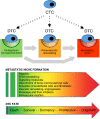The metastatic niche and stromal progression
- PMID: 22699312
- PMCID: PMC3470821
- DOI: 10.1007/s10555-012-9373-9
The metastatic niche and stromal progression
Abstract
The tumor stroma is comprised of extracellular matrix, non-malignant cells, and the signaling molecules they produce. It is an integral and vital component of primary tumors that together with the underlying genetic defects in the tumor cells determines the growth characteristics, morphology, and invasiveness of the tumor. In parallel to continuing genetic changes in the tumor cells themselves, the tumor stroma progressively evolves during primary tumor development. Cancer cells that disseminate from primary tumors are dependent on this stromal microenvironment, and therefore the microenvironment they encounter at secondary sites determines their fate. For those cells that survive at these sites, stromal progression can serve to re-establish a supportive tumor stroma, fostering the outgrowth of the cells as metastases. Formation of a metastatic niche that supports the survival and growth of disseminated tumor cells is a key feature of this stromal progression. The endogenous organ microenvironment can provide components of the metastatic niche. In addition, microenvironmental changes in organs prior to receipt of disseminated tumor cells can be induced by factors secreted systemically by primary tumors, causing the formation of pre-metastatic niches. Further maturation of metastatic niches can be responsible for the re-activation of dormant disseminated tumor cells many years after removal of the primary tumor. The concept of the metastatic niche and stromal progression has profound consequences for our understanding of metastatic disease, and promises to open up new strategies for the diagnosis, prognostic evaluation, and therapy of cancer.
Figures


References
-
- Sleeman JP, Nazarenko I, Thiele W. Do all roads lead to Rome? Routes to metastasis development. International Journal of Cancer. 2011;128(11):2511–2526. - PubMed
-
- Sleeman, J. P., Christofori, G., Fodde, R., J.G., C., Berx, G., Decraene, C., et al. (2012). Concepts of metastasis in flux: the stromal progression model. Seminars in Cancer Biology, 22(3), 174–186. - PubMed
-
- Paget S. The distribution of secondary growths in cancer of the breast. Lancet. 1889;I:571–573. - PubMed
Publication types
MeSH terms
LinkOut - more resources
Full Text Sources
Other Literature Sources

